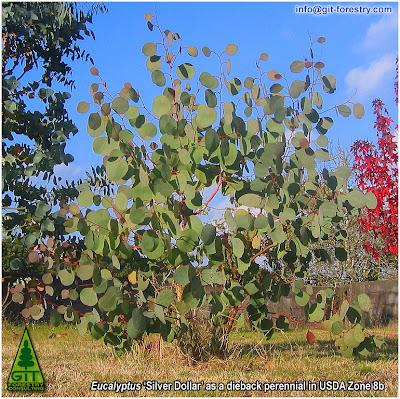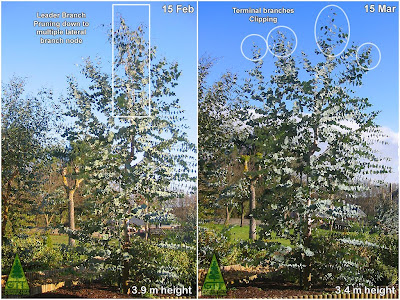Managing growth in ornamental eucalypts: Ongoing Eucalyptus gunnii sculpture in a temperate Atlantic garden
Gustavo Iglesias Trabado
 Fig. 1: Pollarded & pruned ornamental Eucalyptus 65 weeks after planting
Fig. 1: Pollarded & pruned ornamental Eucalyptus 65 weeks after planting
Gustavo Iglesias Trabado

GIT Forestry Consulting - Consultoría y Servicios de Ingeniería Agroforestal - www.git-forestry.com - EUCALYPTOLOGICS
We had previously seen in EUCALYPTOLOGICS some images on first year growth of ornamental Eucalyptus cultivated in our own garden and some explanatory texts on 5 steps of horticultural recommendations at each stage of cultivation in order to control their height and shape along their early growth years.
 Fig. 1: Pollarded & pruned ornamental Eucalyptus 65 weeks after planting
Fig. 1: Pollarded & pruned ornamental Eucalyptus 65 weeks after plantingThe early results after performing sensible pollarding and pruning on garden Eucalyptus were quite pleasing (Fig. 1). We revisit now this topic to show the evolution of these pollarded and pruned eucalypts during their second autumn and winter on the ground.
Retaining juvenile foliage in Eucalyptus is not an easy task. For the case of this garden specimen, leaf change started barely 15 months after planting (Fig. 2, left), so somewhere near age 36 months if we include the cultivation cycle of this plant at nursery prior to planting.
When eucalypt species bearing striking juvenile foliage as Eucalyptus gunnii and other similar looking types start showing intermediate leaves, the normal thought of a gardener involves pruning quickly to "remove the odd looking branches".
But this can be a hasty decision if done without considering the timeframes of your frost risk season. In our case, we decided to do some minor pruning (Fig. 2, right) and wait for the veredict of winter frosts before taking a too drastic step.
Some 40 frost events later, including a steep air temperature drop from 12ºC (53ºF) to -8.5ºC (17ºF) in just 18 hours (Fig. 3), the overall status of this plant is good. Not surprising if we consider it is one of the cold hardiest Eucalyptus and it can be grown safely in the climatic conditions of my garden, unlike others. However, the newest and most fragile growth was lightly battered by frost and chilly winds and showed a mild degree of frost damage after the worst of winter (Fig. 4, left).
Some 40 frost events later, including a steep air temperature drop from 12ºC (53ºF) to -8.5ºC (17ºF) in just 18 hours (Fig. 3), the overall status of this plant is good. Not surprising if we consider it is one of the cold hardiest Eucalyptus and it can be grown safely in the climatic conditions of my garden, unlike others. However, the newest and most fragile growth was lightly battered by frost and chilly winds and showed a mild degree of frost damage after the worst of winter (Fig. 4, left).
So, in this case and regardless of our haste to prune in a high risk season as late autumn, Captain Winter itself showed us what was to be pruned on time once the highest risk of catastrophic frosts is over for this winter and the first signs of spring appear (Fig. 4, left). A simple pruning intervention took place on the leader branch, removing damaged foliage and some 0.5 meters of height growth (Fig. 4, right) by cutting some inches above a nice trunk area where several lateral branches grow in several directions. It is expected several of these lateral branches do gain in size at once, avoiding apical dominance of just one of them.
And now, spring has just arrived here. Some extra clipping operations are to be performed on the latest growth of these lateral branches to encourage a thicker foliage. And after that is done, a new growth season starts.
And now, spring has just arrived here. Some extra clipping operations are to be performed on the latest growth of these lateral branches to encourage a thicker foliage. And after that is done, a new growth season starts.
This pollarded and repeatedly pruned "big bonsai" Eucalyptus gunnii is being tamed to try to fit it in small garden designs via regular size control. If no operation was performed to regulate early growth during the first 100 weeks, current tree height would be in the range of 6 to 8 meters, basal branches bearing juvenile foliage would have already been lost and tree stability in high wind events might be compromised.
Also in this site
 Pruning ornamental eucalypts: Sculpting Eucalyptus gunnii
Pruning ornamental eucalypts: Sculpting Eucalyptus gunnii Ornamental Eucalyptus: from seed to sculpted "Big Bonsai" container plants
Ornamental Eucalyptus: from seed to sculpted "Big Bonsai" container plants Ornamental Eucalyptus as dieback perennials: taking advantage of plant resurrection
Ornamental Eucalyptus as dieback perennials: taking advantage of plant resurrection Grow Eucalyptus from seed: it is in the details
Grow Eucalyptus from seed: it is in the details Contact GIT Forestry Consulting - Eucalyptologics
Contact GIT Forestry Consulting - Eucalyptologics Subscribe to receive EUCALYPTOLOGICS via RSS
© 2007-2008 Gustavo Iglesias Trabado. Please contact us if you want to use all or part of this text and photography elsewhere. We like to share, but we do not like rudeness.





Eucalyptus gunnii starting to bloom
ReplyDeletePosted by Michael Athens, Tn on 10/27/2008, 8:17 pm
I noticed that my Eucalyptus tree was starting to bloom yesterday, it bloomed for the first time last year at this same time and continued through November.
I wonder why it is blooming in the fall when I've read that Eucalyptus gunnii usually blooms in late spring to early summer other places. The coldest temperatures it saw last winter was 9 F (-12c) with two daytime highs near 20 F (-7c) with many hours below freezing. It had no dieback and is near 30 feet tall. We may have early fall freezes and late spring freezes here in east Tennessee but this tree doesn't seem to mind.